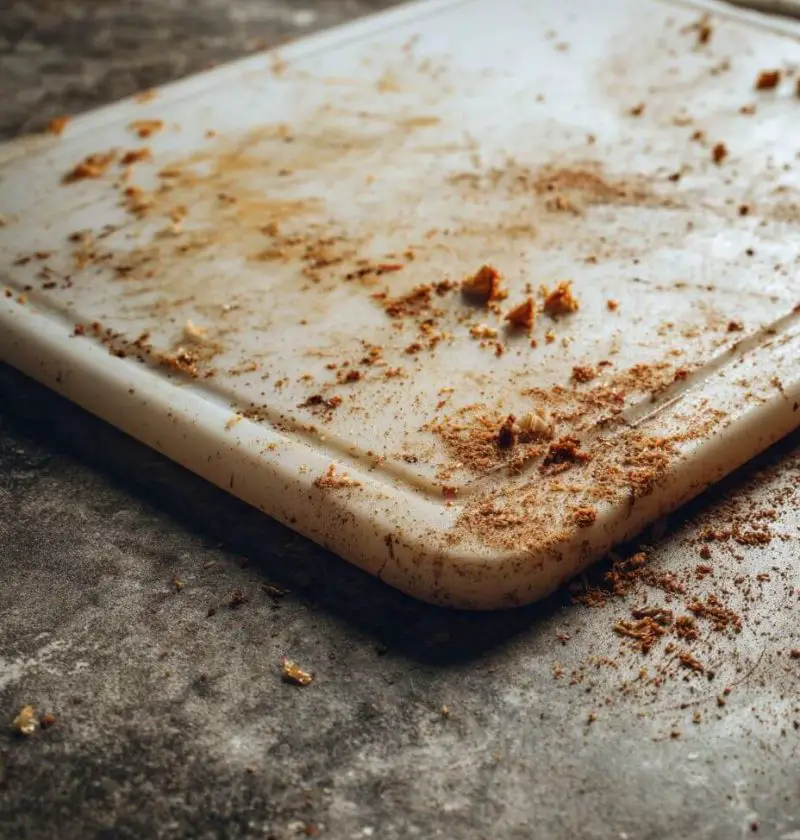Save This Recipe
Let me tell you—white plastic cutting boards are one of those things that seem like a great idea when you buy them. Clean, lightweight, cheap. They go with everything in the kitchen. But give it a few months, and they start showing their age real fast.
Before you know it, they’ve picked up every stain from dinner last week—and a few mystery ones, too. Tomato juice, turmeric, garlic smells… it all clings to those boards like nobody’s business.
Well, a few years back, my ma shared a little trick with me that she swore by. And like most things ma passed down, it’s simple, doesn’t cost much, and it works. So if your board’s looking a little worse for wear, hang tight. I’ve got you covered.
Why Do These Boards Get So Nasty So Fast?
Here’s what most folks don’t realize: plastic cutting boards may look solid, but they’ve actually got tiny little grooves and pores all over them. Every time you cut something—especially something juicy or colorful—bits of it sneak in there. Over time, those stains settle in like unwanted guests.
Add in strong odors like garlic or onions, and you’ve got yourself a board that smells like last Tuesday’s dinner even after washing it three times.
What You’ll Need for Ma’s Magic Mix
No fancy cleaners. No scrubbing your arm off. Just a few things you’ve probably already got:
-
Baking soda – gentle scrubber and deodorizer
-
Hydrogen peroxide – lifts stains and kills germs
-
Dish soap – cuts grease and leftover food bits
That’s it. Really.
The No-Fuss Method
Alright, here’s how I do it—usually on a lazy Sunday when I’m cleaning the kitchen anyway.
-
Dry the Board
This works best when your board is dry, so give it a quick towel-off if it’s damp. -
Generous Sprinkle of Baking Soda
Cover the whole board. You don’t need to cake it on, but be generous. Think of it like flouring a countertop for dough. -
Add Hydrogen Peroxide
Pour just enough to make a paste. It’ll fizz—that’s totally normal and part of the magic. -
A Couple Drops of Dish Soap
Any dish soap will do. This helps loosen greasy spots and stuck-on food bits. -
Let It Rest
Leave it alone for 10 to 15 minutes. Seriously—go fold some laundry or scroll your phone. You don’t have to babysit it. -
Rinse & Wipe
Use warm water and a soft sponge to rinse it all off. No scrubbing needed unless you want to. The stains should lift right out, and that funky smell? Gone. -
Dry It Off
Give it a good towel dry or let it air dry completely. Done and done.
Why It Works (Without Getting Too Science-y)
-
Baking soda is mildly abrasive, so it gets into those tiny grooves without damaging the surface.
-
Hydrogen peroxide is like a gentle, food-safe bleach. It pulls out the stains and helps kill any lingering bacteria.
-
Dish soap is your grease-fighting buddy. It makes sure nothing sticky stays behind.
Put them all together? You’ve got yourself one heck of a cleaning combo.
A Few Extra Tips From My Kitchen to Yours
-
Clean right after chopping – it keeps the board from absorbing colors and smells.
-
Skip the dishwasher – I know it’s tempting, but heat can warp plastic over time.
-
Rub with a lemon once in a while – it freshens things up and helps sanitize naturally.
-
Don’t go hard on the scrubbing – abrasive scrubbers can make the plastic rougher and more prone to future stains.
Wrapping It Up
This little trick has saved more than a few cutting boards in my kitchen—and it’s so easy, I’ve got no excuse not to do it. Honestly, once you’ve tried it, you’ll wonder why you ever let those stains stick around in the first place.
It’s quick, it’s cheap, and it works. And hey, it’s kind of satisfying to bring something back to life with just a little kitchen chemistry.
So the next time you look at your cutting board and think “Ugh, I should just toss it,” give this a try instead. Ma would be proud.

